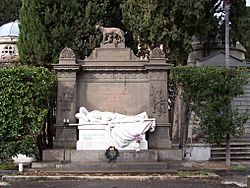Goffredo Mameli facts for kids
Quick facts for kids
Goffredo Mameli
|
|
|---|---|
 |
|
| Born | 5 September 1827 Genoa, Italy
|
| Died | 6 July 1849 (aged 21) Rome, Italy
|
| Resting place | Mausoleo Ossario del Gianicolo, Janiculum, Italy |
| Nationality | Italian |
| Occupation | patriot, poet, and writer |
| Known for | wrote the lyrics of the original version of the Italian national anthem "Il Canto degli Italiani" |
Goffredo Mameli (born September 5, 1827 – died July 6, 1849) was an Italian hero, poet, and writer. He played an important part in the Risorgimento, which was the movement to unite Italy into one country. He is most famous for writing the words to "Il Canto degli Italiani", which is now Italy's national anthem.
Contents
Goffredo Mameli: A Young Italian Hero
Goffredo Mameli was born in Genoa, Italy. His father was an important admiral in the navy of the Kingdom of Sardinia. When Goffredo was seven, he went to live with his grandfather in Sardinia to avoid a sickness called cholera. But he soon returned to Genoa to finish his schooling.
Goffredo Mameli lived a very short life, but he achieved a lot in just two years. During this time, he was a key figure in the movements that led to Italy becoming a united country.
Early Steps Towards Italian Unity
In 1847, Mameli joined a cultural group called Società Entelema. This group soon became involved in politics. Here, Mameli became interested in the ideas of Giuseppe Mazzini, who was a leader in the Italian unification movement.
Mameli is best known for writing the words to Italy's national anthem, Il Canto degli Italiani. The music for this anthem was composed by Michele Novaro. In Italy, people often call it Inno di Mameli, which means "Mameli's Hymn". The words were first used in November 1847 to celebrate King Charles Albert of Sardinia when he visited Genoa. Another one of Mameli's songs, "Suona la tromba", had music added by the famous composer Giuseppe Verdi the next year.
Fighting for Freedom
Mameli was very involved in the movements to unite Italy. He took part in some brave actions, like showing the Tricolore (the Italian flag) in 1846. At that time, the flag was not allowed. He did this to celebrate the Austrians leaving Italy. He also worked with Nino Bixio, who later became a close friend and supporter of Giuseppe Garibaldi.
In March 1848, when Mameli heard about an uprising in Milan, he quickly gathered 300 other patriots. They joined Bixio's troops and entered the city. Mameli then became a captain in Garibaldi's volunteer army and met Mazzini.
Back in Genoa, Mameli focused more on writing. He wrote several songs and other works. He also became the director of a newspaper called Diario del Popolo ("People's Daily"). Through the newspaper, he encouraged people to support a war against Austria.
In December 1848, Mameli went to Rome. He helped secretly prepare for the declaration of the Roman Republic on February 9, 1849. Mameli then traveled to Florence where he suggested creating a single state between Tuscany and Lazio.
In April 1849, he was back in Genoa with Bixio. There was a popular uprising there, but General Alberto La Marmora strongly opposed it. Mameli soon left for Rome again. The French army had arrived to support the Pope, who had actually left the city. Mameli actively took part in the fighting.
His Final Days
During the siege of Rome, Mameli was an assistant to Giuseppe Garibaldi. He fought in battles in Palestrina (May 9) and Velletri (May 19). He especially fought bravely in the defense of the Villa del Vascello on the Janiculum hill.
On June 3, during the last attack at Villa Corsini, which was taken by the French, Mameli was wounded in his left leg. Some people believe he might have been accidentally wounded by a fellow soldier's bayonet.
Mameli's wound became very infected. Doctors decided to amputate his leg, but the infection continued to spread. He sadly died from the infection on July 6, 1849. He was only 21 years old. He was first buried in Campo Verano in Rome. Later, in 1941, his remains were moved to the Mausoleo Ossario del Gianicolo.
See also
 In Spanish: Goffredo Mameli para niños
In Spanish: Goffredo Mameli para niños



